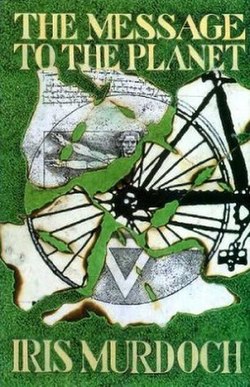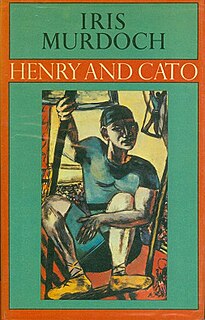
Dame Jean Iris Murdoch was an Irish and British novelist and philosopher. Murdoch is best known for her novels about good and evil, sexual relationships, morality, and the power of the unconscious. Her first published novel, Under the Net (1954), was selected in 1998 as one of Modern Library's 100 best English-language novels of the 20th century. Her 1978 novel The Sea, the Sea won the Booker Prize. In 1987, she was made a Dame by Queen Elizabeth II for services to literature. In 2008, The Times ranked Murdoch twelfth on a list of "The 50 greatest British writers since 1945".

Cathal Brugha was an republican politician who served as Minister for Defence from 1919 to 1922, Ceann Comhairle of Dáil Éireann in January 1919, the first president of Dáil Éireann from January 1919 to April 1919 and Chief of Staff of the Irish Republican Army from 1917 to 1919. He served as a Teachta Dála (TD) from 1918 to 1922.

The Sea, the Sea is a novel by Iris Murdoch. Published in 1978, it was her nineteenth novel. It won the 1978 Booker Prize.

Veronica Guerin was an Irish crime reporter who was murdered by drug lords. Born in Dublin, she was an athlete in school and later played on the Irish national teams for both football and basketball. After studying accountancy she ran a public-relations firm for seven years, before working for Fianna Fáil and as an election agent for Seán Haughey. She became a reporter in 1990, writing for the Sunday Business Post and Sunday Tribune. In 1994 she began writing about crime for the Sunday Independent. In 1996 she was fatally shot while stopped at a traffic light. The shooting caused national outrage in Ireland. Investigation into her death led to a number of arrests and convictions.

Frances Power Cobbe was an Anglo-Irish writer, philosopher, religious thinker, social reformer, anti-vivisection activist and leading women's suffrage campaigner. She founded a number of animal advocacy groups, including the National Anti-Vivisection Society (NAVS) in 1875 and the British Union for the Abolition of Vivisection (BUAV) in 1898, and was a member of the executive council of the London National Society for Women's Suffrage.
Events from the year 1999 in Ireland.
Events from the year 1996 in Ireland.

Odd Man Out is a 1947 British film noir directed by Carol Reed, and starring James Mason, Robert Newton, Cyril Cusack, and Kathleen Ryan. Set in a Northern Irish city, it follows a wounded Nationalist leader who attempts to evade police in the aftermath of a robbery. It is based on the 1945 novel of the same name by F. L. Green.

Charlie Kerins was a physical force Irish Republican, and Chief of Staff of the Irish Republican Army. After spending two years on the run he was captured by the Gardaí in 1944. Following his subsequent trial and conviction for the 1942 murder of Garda Detective Sergeant Denis O'Brien, Kerins was hanged at Mountjoy Prison in Dublin.

"On Raglan Road" is a well-known Irish song from a poem written by Irish poet Patrick Kavanagh named after Raglan Road in Ballsbridge, Dublin. In the poem, the speaker recalls a love affair that he had with a young woman while walking on a "quiet street". Although the speaker knew that he would risk being hurt if he initiated a relationship, he did so anyway.

A Fairly Honourable Defeat is a novel by the British writer and philosopher Iris Murdoch. Published in 1970, it was her thirteenth novel.

Cathal Ó Searcaigh, is a modern Irish language poet. His work has been widely translated, anthologised and studied. "His confident internationalism", according to Theo Dorgan, has channelled "new modes, new possibilities, into the writing of Irish language poetry in our time".
Cathal Breslin is a concert pianist originally from Derry, Northern Ireland, now living in Phoenix, Arizona in the United States. He has performed extensively in solo recitals, as a concerto soloist with orchestra and a chamber musician in major concert halls throughout Europe, North America, South America and Asia. He is currently Associate Professor of Piano at the Arizona State University School of Music, Dance and Theatre in the Herberger Institute for Design and the Arts in the United States. He is an exclusive Yamaha Performing Artist. In 2008 he founded the Walled City Music Festival with his wife, American flautist Dr. Sabrina Hu. It has featured artists such as the Kronos Quartet, Bang on a Can All Stars, BBC Ulster Orchestra, Sir James Galway, Katia and Marielle Labèque, Augustin Dumay, Anne Akiko Meyers, Dmitry Sitkovetsky, Jan Vogler, Raphael Wallfisch, Jeffrey Zeigler, Jonathan Lemalu, Brodsky Quartet, Fitzwilliam Quartet, Houston Winds, Jeremy Denk, Awadagin Pratt, Kirill Troussov, among many others.

The Message to the Planet is a novel by Iris Murdoch. Published in 1989, it was her twenty-fourth novel.

The Nice and the Good is a novel by Iris Murdoch. Published in 1968, it was her eleventh novel. The Nice and the Good was shortlisted for the 1969 Booker Prize.

An Unofficial Rose is a novel by Iris Murdoch. Published in 1962, it was her sixth novel.

Henry and Cato is a novel by Iris Murdoch. Published in 1976, it was her eighteenth novel.

An Accidental Man is a novel by Iris Murdoch, which was published in 1971. It was her fourteenth novel.

The Time of the Angels is a philosophical novel by British novelist Iris Murdoch. First published in 1966, it was her tenth novel. The novel centres on Carel Fisher, an eccentric Anglican priest who is the rector of a London church which was destroyed by bombing during World War II. Fisher denies the existence of God and the possibility of human goodness in a post-theistic world. The novel, which has elements of Gothic fiction, received mixed reviews on its publication.
















